It can feel like we’re being bombarded with messages about animal-sourced foods being the ‘bad guys’ for the environment. But when it comes to sustainable healthy diets it’s time to stop thinking of plant foods as ‘good’ and animal-sourced foods as ‘bad’, say the authors of this article.
Instead, we need a balance of plant and animal foods for good health, and both offer valuable social, economic and environmental benefits.
What do food-based dietary guidelines (FBDGs) say about sustainability?
In the face of mounting concerns about climate change and the environment as well as the future of our food supplies, some FBDGs have started to include sustainability recommendations. Recent updates encourage people to eat more plant-sourced foods and less animal-sourced food.
But this message is too simplistic and we should also consider other factors when we’re assessing sustainable healthy diets, say the authors.
Health effects of foods are more than just nutrients
Plant and animal foods contain a wide variety of nutrients, some of which are only present in one or the other. That’s why a balanced combination of plant and animal foods is important.
Apart from their nutrient content, many factors need to be considered when assessing the potential health effects of foods. Some examples are probiotics, bioactive compounds, the structure of the food (food matrix), interactions between foods, processing, and food preparation effects.
Plant and animal foods have complementary roles in sustainable healthy diets
Plant and animal agriculture both use environmental resources such as water and land, and both provide environmental benefits and economic livelihoods. The environmental impact of a food depends not only on whether it’s a plant or animal food but also on the region of the world, the production methods and transportation involved.
Plants play a vital role in regulating the levels of gases in the atmosphere. They produce oxygen on which we depend for our survival, and they remove carbon dioxide from the atmosphere which helps to limit climate change.
Animal foods are valuable in preventing nutrient deficiencies (eg, protein, calcium, iron). Livestock can graze on land that is unsuitable for growing crops and can eat plant material that is unfit for human consumption, turning it into animal foods – meat, milk, eggs. Animal manure can be used to improve plant growth. Plant and animal by-products are used to create biofuels that help to reduce our dependence on fossil fuels.
Scientific collaboration is the way forward
Global food systems must change, say the authors. We need to produce more plant and animal foods to feed a growing global population. At the same time we need to reduce the environmental impact of plant and animal agriculture while supporting people’s livelihoods and community life.
A raft of initiatives is underway to improve research methods and encourage people around the world involved in agriculture, health and sustainability to work together. The authors call for FBDGs to continue to guide people towards dietary options that best support human and planetary health and which improve socio-economic wellbeing.
‘In addition to the essential steps of improving dietary diversity and variety, a move towards increased consumption of nutrient- and bioactive-rich foods such as fruits, vegetables, and dairy foods in place of lower-nutrient and higher environmental-impact foods is an actionable food-based step toward a solution [to making diets healthier and more sustainable].’ – Comerford et al, 2021.



